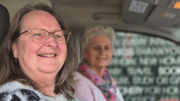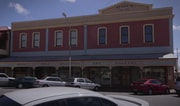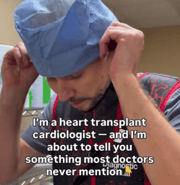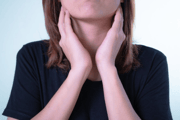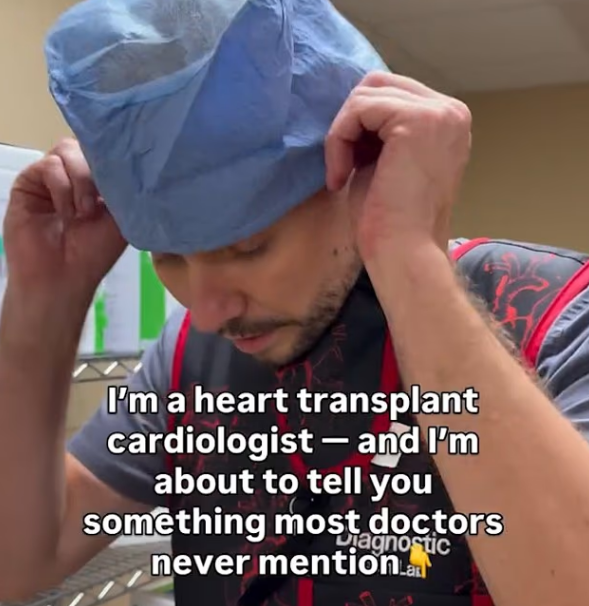
Every 12 minutes, another Australian loses their life to cardiovascular disease. CVD accounts for one in four of all deaths, claiming the life of one person every 12 minutes, making it our nation's biggest killer. But what if the solution to reducing your heart attack risk was literally right beneath you—in your calf muscles?
A US cardiologist's viral warning about our body's 'second heart' has captured attention worldwide, and the science behind it could be a game-changer for Australian seniors.
Dr Dmitry Yaranov's Instagram video, watched over 3.6 million times, reveals why your calf muscles might be the most undervalued part of your cardiovascular system.
'You don't have one heart, you have two,' Dr Yaranov explains. 'The first is in your chest. The second is in your calves.' This isn't just catchy social media content—it's backed by solid medical science that could revolutionise how we think about heart health.
The alarming reality for Australian hearts
CVD was the underlying cause of 45,000 deaths (24 per cent of all deaths) in 2022 across Australia, with ischaemic heart disease accounting for 17,331 deaths, with death rates twice as high for males as for females.
Even more concerning, every year, 57,000 Australians suffer a heart attack, with every nine minutes, one person hospitalised due to a heart attack.
The statistics paint a sobering picture for our ageing population. Prevalence increased with age, from 0.6 per cent of people aged 0—44 years to 27.7 per cent of people aged 75 years and over, meaning more than one in four Australians over 75 live with cardiovascular disease.
Yet here's what's particularly troubling: many of these heart problems could potentially be prevented by something as simple as activating your calf muscles daily.
'Every step, every heel raise, every muscle squeeze pushes blood back to your real heart, keeps your circulation alive, and stops deadly clots from forming'
The science behind your 'second heart'
Calf muscle pump is the motive force enhancing return of venous blood from the lower extremity to the heart, functioning as what medical professionals genuinely call our 'second heart.' The calf muscles are your 'second heart,' squeezing veins in the lower legs to help return deoxygenated blood from the feet back up towards the chest.
The mechanism is remarkable in its elegance. Calf muscle contraction elevates the pressure to approximately 140 mm Hg and expels venous blood into the popliteal and femoral veins.
Every time the calf muscle contracts, one-way valves inside the leg veins open and blood gets pushed upwards towards the heart; when the calf muscle relaxes, the valves close, which prevents blood from flowing backwards into the legs.
Without this pumping action, the blood flow back to the heart has to fight the force of gravity, which keeps everything down. So without a natural pumping mechanism, there's no way for the blood to get back to the heart, according to Dr Teresa Wu from the Cleveland Clinic.
Research published in medical journals confirms this isn't just theoretical. One study published in the Journal of Biomechanics found that men and women with chronic heart failure had smaller calf muscles than healthy people with fully functional hearts, establishing a clear connection between calf strength and heart health.
How Your Calf Muscle Pump Works
When you walk or move, your calf muscles contract and compress the deep veins in your legs, creating pressure up to 140mmHg. This pressure pushes deoxygenated blood upward toward your heart, while one-way valves prevent it from flowing back down. When the muscle relaxes, the cycle repeats, effectively creating a secondary pumping system that assists your heart.
The Australian activity crisis
Here's where the story takes a concerning turn for Australian seniors. Despite the clear benefits of movement for heart health, 57 per cent of adults aged 65 and over were insufficiently physically active, with this being higher in women (60 per cent) than men (53 per cent).
Even more alarming, only 41.8 per cent of older Australians are meeting the physical activity guidelines, meaning nearly six in ten Australian seniors aren't getting enough movement to keep their 'second heart' functioning optimally.
The Australian Government recommends that people aged 65 years and over engage in at least 30 minutes of moderate intensity physical activity on most, preferably all, days. Yet 39 per cent were completely physically inactive (that is, did 0 days of physical activity in the last week).
This sedentary lifestyle directly impacts the calf muscle pump. When people spend a lot of time sitting or standing, pressure can build up in the veins and damage the valves over time, making them 'leaky' and causing more blood to pool in the legs.
Losing the calf muscle pump function can lead to symptoms of chronic vein disease, such as swelling, leg tiredness and varicose veins.
When your second heart fails
The consequences of an inactive calf muscle pump extend far beyond tired legs. The worst medical complication could be a blood clot, which is rare but can happen when people sit for many hours on a long flight without getting up.
If you don't move for long periods, blood and toxins will collect in your lower legs and cause swelling. Deep vein thrombosis or DVT occurs when blood pools in one or more of the deep veins in your body, and forms a clot.
For your primary heart, an inactive second heart means working overtime. By aiding venous return, the calf muscles lower the effort required by the heart to circulate blood, especially during physical activity. When this assistance fails, your heart must work harder, potentially contributing to the cardiovascular problems plaguing so many Australians.
Did you know?
Did you know?
Physical inactivity contributes to 14 per cent of the coronary heart disease burden in Australia, making it a significant preventable risk factor that's often overlooked compared to diet and blood pressure concerns.
Activating your second heart: beyond just walking
While Dr Yaranov's advice focuses on walking, Australian seniors have multiple options for activating their calf muscle pump, especially important given our diverse physical capabilities and health conditions.
The walking foundation
Take a walking break as often as you can, but at least once or twice an hour. 'I would just encourage everybody to walk as often as they can, especially if you have a desk job or a standing job', advises Dr Wu.
Desk-bound alternatives
For those who can't get up regularly, do toe raises — flex the foot up and down — which is the closest you can get to mimicking the motion of taking a step. This is particularly relevant for many Australian seniors who may have mobility limitations.
Calf raises anywhere
Stand with your feet together or slightly apart and raise your heels so that you're standing on the balls of your feet. Lower your heels, and then lift them up again. Continue lifting and lowering for at least 10 repetitions.
The stair advantage
Dr Yaranov specifically mentions taking the stairs, and for good reason. This engages the calf muscles more intensively than level walking, providing a more robust activation of your second heart.
Simple Daily Calf Activation Strategies
- Walk for at least 10 minutes, twice daily if 30 minutes feels overwhelming
- Perform calf raises during TV viewing or while waiting for the kettle
- Take regular breaks from sitting every hour, even just to stand and flex feet
- Use stairs when possible, or step up and down on a bottom step at home
- Consider heel-to-toe walking for balance and calf engagement
Safe activation for Australian seniors
Given that people over the age of 65, more than any other age group, require adequate fitness levels to help them maintain independence, recover from illness and reduce their high risk of disease, the approach to activating your second heart should be both effective and safe.
The Australian guidelines are encouraging for those starting from low activity levels. If you find 30 minutes difficult right now, start with just 10 minutes once or twice a day. After 2 weeks, increase to 15 minutes twice a day.
For specific health conditions:
If you have heart problems, diabetes or asthma—you can start moderate walking or swimming; arthritis—you can try hydrotherapy or swimming in a warm pool; osteoporosis—you can try weight bearing and strength activities.
Elevation benefits
Elevating the legs can also be helpful, especially for people who already have symptoms of chronic vein disease. It has to be over the level of the heart, so propping legs up on a stool won't do much. It's best to lie in bed with your legs up on pillows or lie on a couch with your legs resting on an armrest.
Australian resources for heart-healthy movement
Australia offers numerous programs specifically designed to help seniors stay active and support their cardiovascular health. Stay on Your Feet is the Western Australia Department of Health's falls prevention program, offering information and resources about safe exercise for older Australians.
The National Ageing Research Institute (NARI) provides links to exercise programs you can do at home. Department of Health, Disability and Ageing provides physical activity and exercise guidelines for older people. They also provide a physical guide for older Australians.
Many local councils across Australia offer walking groups specifically for seniors, providing both the social connection and regular movement needed to keep your second heart active. Community centres often run gentle exercise programs that incorporate calf-strengthening activities.
The broader circulation benefits
Activating your calf muscle pump delivers benefits that extend far beyond just heart health. Improved circulation enhances blood circulation, reducing the risk of conditions like deep vein thrombosis (DVT), varicose veins, and edema. Regular movement of the calf muscles prevents blood stagnation, reducing the likelihood of clots and other cardiovascular complications.
It aids in returning blood to the heart, ensuring proper oxygen and nutrient delivery throughout the body. Keeping blood flowing minimises the chances of blood clots forming in the legs. It promotes lymphatic drainage, which helps remove waste products from the body. Efficient blood flow allows muscles to receive more oxygen, enhancing endurance and performance.
Your second heart maintenance plan
Just as you wouldn't neglect your primary heart, your second heart deserves attention. Just like your actual heart, your second heart needs care and attention.
Stay active with regular exercise, especially activities that engage your calf muscles, like walking, running, and swimming. Maintain a healthy weight as excess weight strains your circulatory system, including your second heart.
For many Australian seniors, the key is consistency rather than intensity. Staying active is about consistency, enjoyment and making movement a part of your daily life. Start small and let your progress motivate you to keep going.
Daily maintenance checklist:
- Take regular movement breaks (every hour if sedentary)
- Perform calf raises during routine activities
- Choose stairs when safely possible
- Walk for at least 10-30 minutes daily
- Elevate legs when resting
- Stay hydrated to maintain blood flow
Example Scenario
- Margaret, 68, from Brisbane was experiencing swollen ankles and fatigue by day's end. After learning about the calf muscle pump, she began setting hourly reminders to do simple calf raises while watching TV and started a daily 15-minute morning walk. Within three weeks, she noticed less swelling and more energy, demonstrating how small changes to activate the 'second heart' can yield meaningful benefits.
The step forward
Various studies show that it is never too late to get fit. The human body responds to exercise, no matter what its age, and there are many health benefits. With every 12 minutes, one Australian dies from CVD, that's 118 deaths every day, the time for action is now.
The beauty of the 'second heart' concept lies in its simplicity. Unlike complex medical interventions or expensive treatments, activating your calf muscle pump requires nothing more than movement—something that's freely available to almost everyone.
Dr Yaranov's closing advice resonates particularly strongly for Australian seniors: 'Don't wait until it's too late—start today. Your future self will thank you.' With our concerning cardiovascular statistics and low activity compliance rates, this message couldn't be more timely.
What This Means For You
Remember, before starting any new exercise routine, especially if you have existing health conditions, talk to your doctor about what activity suits you. But for most Australian seniors, the path to better cardiovascular health might just begin with the simple act of getting those calf muscles moving.
Your second heart is ready to help—are you ready to activate it?
What small step will you take today to get your 'second heart' pumping? Share your walking stories or calf-strengthening tips in the comments below—your experience might inspire another member to take that crucial first step toward better heart health.
Original Article
https://www.dailymail.co.uk/health/...tml?ns_mchannel=rss&ns_campaign=1490&ito=1490
Key statistics: Cardiovascular disease | Heart Foundation
Cited text: CVD accounts for one in four of all deaths, claiming the life of one person every 12 minutes.
Excerpt: CVD accounts for one in four of all deaths, claiming the life of one person every 12 minutes
https://www.heartfoundation.org.au/...d-statistics/key-stats-cardiovascular-disease
Heart, stroke and vascular disease: Australian facts, About—Australian Institute of Health and Welfare
Cited text: Coronary heart disease was the leading cause of disease burden for males in 2024 and seventh for females · CVD was the underlying cause of 45,000 deat...
Excerpt: CVD was the underlying cause of 45,000 deaths (24 per cent of all deaths) in 2022
https://www.aihw.gov.au/reports/heart-stroke-vascular-diseases/hsvd-facts/contents/about
Heart attack, stroke and cardiovascular disease in Australia: Statistics and facts
Cited text: In 2021, the leading cause of death in Australia was ischaemic heart disease (17,331 deaths), accounting for 10.1 per cent of all deaths.1 · CVD kills one in ...
Excerpt: ischaemic heart disease accounting for 17,331 deaths, with death rates twice as high for males as for females
https://www.hri.org.au/health/learn...lar-disease-in-australia-statistics-and-facts
Heart attack, stroke and cardiovascular disease in Australia: Statistics and facts
Cited text: In 2021, the leading cause of death for males was coronary heart disease, accounting for 10,371 (12 per cent) deaths, with death rates twice as high for males...
Excerpt: ischaemic heart disease accounting for 17,331 deaths, with death rates twice as high for males as for females
https://www.hri.org.au/health/learn...lar-disease-in-australia-statistics-and-facts
Heart attack, stroke and cardiovascular disease in Australia: Statistics and facts
Cited text: An estimated 430,000 Australians have had a heart attack at some point in their lives, and every year, 57,000 Australians suffer a heart attack.Every ...
Excerpt: every year, 57,000 Australians suffer a heart attack, with every nine minutes, one person hospitalised due to a heart attack
https://www.hri.org.au/health/learn...lar-disease-in-australia-statistics-and-facts
Heart, stroke and vascular disease, 2022 | Australian Bureau of Statistics
Cited text: Prevalence increased with age, from 0.6 per cent of people aged 0—44 years to 27.7 per cent of people aged 75 years and over.
Excerpt: Prevalence increased with age, from 0.6 per cent of people aged 0—44 years to 27.7 per cent of people aged 75 years and over
https://www.abs.gov.au/statistics/h...rt-stroke-and-vascular-disease/latest-release
Calf Pump Activity Influencing Venous Hemodynamics in the Lower Extremity—PMC
Cited text: ... Calf muscle pump is the motive force enhancing return of venous blood from the lower extremity to the heart.
Excerpt: Calf muscle pump is the motive force enhancing return of venous blood from the lower extremity to the heart
https://pmc.ncbi.nlm.nih.gov/articles/PMC3699225/
Calf Pump Activity Influencing Venous Hemodynamics in the Lower Extremity—PMC
Cited text: Activity of the calf muscle pump is the motive force that significantly affects venous circulation in the lower extremity.
Excerpt: Calf muscle pump is the motive force enhancing return of venous blood from the lower extremity to the heart
https://pmc.ncbi.nlm.nih.gov/articles/PMC3699225/
Are you neglecting your 'second heart'? 1 step to activate it now
Cited text: The calf muscles are your “second heart,” squeezing veins in the lower legs to help return deoxygenated blood from the feet back up towards the chest,...
Excerpt: The calf muscles are your 'second heart,' squeezing veins in the lower legs to help return deoxygenated blood from the feet back up towards the chest
https://www.today.com/health/diet-fitness/what-is-the-second-heart-rcna117576
Calf Pump Activity Influencing Venous Hemodynamics in the Lower Extremity—PMC
Cited text: Calf muscle contraction elevates the pressure to approximately 140 mm Hg and expels venous blood into the popliteal and femoral vein; the pressure dif...
Excerpt: Calf muscle contraction elevates the pressure to approximately 140 mm Hg and expels venous blood into the popliteal and femoral vein
https://pmc.ncbi.nlm.nih.gov/articles/PMC3699225/
Are you neglecting your 'second heart'? 1 step to activate it now
Cited text: “We need the blood to go up the leg to return to the heart … so the calf muscle pump is really important.” · Every time the calf muscle contracts, one...
Excerpt: Every time the calf muscle contracts, one-way valves inside the leg veins open and blood gets pushed upwards towards the heart; when the calf muscle relaxes, the valves close, which prevents blood from flowing backwards into the legs
https://www.today.com/health/diet-fitness/what-is-the-second-heart-rcna117576
Are you neglecting your 'second heart'? 1 step to activate it now
Cited text: “The blood flow back to the heart has to fight the force of gravity, which keeps everything down. So without a natural pumping mechanism, there’s no w...
Excerpt: the blood flow back to the heart has to fight the force of gravity, which keeps everything down.
https://www.today.com/health/diet-fitness/what-is-the-second-heart-rcna117576
Why Is The Calf Muscle Considered The Second Heart? — Shaftesbury Chiropractic Dorset
Cited text: One study published in the Journal of Biomechanics in November of 2014 found that men and women with chronic heart failure had smaller calf muscles th...
Excerpt: One study published in the Journal of Biomechanics found that men and women with chronic heart failure had smaller calf muscles than healthy people with fully functional hearts
https://shaftesburychiropractic.co.uk/advice/why-is-the-calf-muscle-considered-the-second-heart
Physical activity—Australian Institute of Health and Welfare
Cited text: In 2022, based on self-reported data from the ABS 2022 NHS, 57 per cent of adults aged 65 and over were insufficiently physically active. This was higher in w...
Excerpt: 57 per cent of adults aged 65 and over were insufficiently physically active, with this being higher in women (60 per cent) than men (53 per cent)
https://www.aihw.gov.au/reports/physical-activity/physical-activity
Physical activity for seniors | Better Health Channel
Cited text: Currently according to ABS (2022) only 41.8 per cent of older Australians are meeting these guidelines.
Excerpt: only 41.8 per cent of older Australians are meeting the physical activity guidelines
https://www.betterhealth.vic.gov.au/health/healthyliving/physical-activity-for-seniors
Physical activity for seniors | Better Health Channel
Cited text: Currently according to ABS (2022) only 41.8 per cent of older Australians are meeting these guidelines.
Excerpt: only 41.8 per cent of older Australians are meeting the physical activity guidelines
https://www.betterhealth.vic.gov.au/health/healthyliving/physical-activity-for-seniors
For older Australians (65 years and over) | Australian Government Department of Health, Disability and Ageing
Cited text: For people aged 65 years and over, we recommend at least 30 minutes of moderate intensity physical activity on most, preferably all, days.
Excerpt: people aged 65 years and over engage in at least 30 minutes of moderate intensity physical activity on most, preferably all, days
https://www.health.gov.au/topics/ph...lians/for-older-australians-65-years-and-over
Physical activity—Australian Institute of Health and Welfare
Cited text: 39 per cent were completely physically inactive (that is, did 0 days of physical activity in the last week).
Excerpt: 39 per cent were completely physically inactive (that is, did 0 days of physical activity in the last week)
https://www.aihw.gov.au/reports/physical-activity/physical-activity
Are you neglecting your 'second heart'? 1 step to activate it now
Cited text: When people spend a lot of time sitting or standing, pressure can build up in the veins and damage the valves over time, making them “leaky” and causi...
Excerpt: When people spend a lot of time sitting or standing, pressure can build up in the veins and damage the valves over time, making them 'leaky' and causing more blood to pool in the legs.
https://www.today.com/health/diet-fitness/what-is-the-second-heart-rcna117576
Are you neglecting your 'second heart'? 1 step to activate it now
Cited text: The worst medical complication could be a blood clot, which is rare but can happen when people sit for many hours on a long flight without getting up,...
Excerpt: The worst medical complication could be a blood clot, which is rare but can happen when people sit for many hours on a long flight without getting up
https://www.today.com/health/diet-fitness/what-is-the-second-heart-rcna117576
Caring for your 'second heart' | Center For Advanced Vein ...
Cited text: If you don’t move for long periods, blood and toxins will collect in your lower legs and cause swelling. Deep vein thrombosis or DVT occurs when blood...
Excerpt: If you don't move for long periods, blood and toxins will collect in your lower legs and cause swelling.
https://yourhealthyveins.com/caring-for-your-second-heart/
Calf Muscles and Health Heart | Aster
Cited text: Reduced Strain on the Heart: By aiding venous return, the calf muscles lower the effort required by the heart to circulate blood, especially during ph...
Excerpt: By aiding venous return, the calf muscles lower the effort required by the heart to circulate blood, especially during physical activity
https://www.asterhospitals.in/blogs-events-news/aster-rv-bangalore/calf-muscles-and-health-heart-0
Are you neglecting your 'second heart'? 1 step to activate it now
Cited text: Just walk — take a walking break as often as you can, but at least once or twice an hour, both experts say.
Excerpt: Take a walking break as often as you can, but at least once or twice an hour. 'I would just encourage everybody to walk as often as they can, especially if you have a desk job or a standing job'
https://www.today.com/health/diet-fitness/what-is-the-second-heart-rcna117576
Are you neglecting your 'second heart'? 1 step to activate it now
Cited text: “Keep moving.” · “I would just encourage everybody to walk as often as they can, especially if you have a desk job or a standing job,” Wu adds.
Excerpt: Take a walking break as often as you can, but at least once or twice an hour. 'I would just encourage everybody to walk as often as they can, especially if you have a desk job or a standing job'
https://www.today.com/health/diet-fitness/what-is-the-second-heart-rcna117576
Are you neglecting your 'second heart'? 1 step to activate it now
Cited text: If you’re on a plane or stuck at your desk at work and can’t get up, do toe raises — flex the foot up and down — which is the closest you can get to m...
Excerpt: do toe raises — flex the foot up and down — which is the closest you can get to mimicking the motion of taking a step
https://www.today.com/health/diet-fitness/what-is-the-second-heart-rcna117576
Why Is the Calf Muscle Considered the Second Heart?—Personal Best Fitness
Cited text: The following calf-strengthening exercises are good options: Calf Raises—This is a simple movement that you can do throughout the day in any locatio...
Excerpt: Stand with your feet together or slightly apart and raise your heels so that you're standing on the balls of your feet.
https://personalbestfitness.com/why-is-the-calf-muscle-considered-the-second-heart/
Physical activity for seniors | Better Health Channel
Cited text: It has been suggested that people over the age of 65, more than any other age group, require adequate fitness levels to help them maintain independenc...
Excerpt: people over the age of 65, more than any other age group, require adequate fitness levels to help them maintain independence, recover from illness and reduce their high risk of disease
https://www.betterhealth.vic.gov.au/health/healthyliving/physical-activity-for-seniors
For older Australians (65 years and over) | Australian Government Department of Health, Disability and Ageing
Cited text: If you find 30 minutes difficult right now, start with just 10 minutes once or twice a day. After 2 weeks, increase to 15 minutes twice a day.
Excerpt: If you find 30 minutes difficult right now, start with just 10 minutes once or twice a day.
https://www.health.gov.au/topics/ph...lians/for-older-australians-65-years-and-over
For older Australians (65 years and over) | Australian Government Department of Health, Disability and Ageing
Cited text: For example, if you have: heart problems, diabetes or asthma—you can start moderate walking or swimming · arthritis—you can try hydrotherapy or sw...
Excerpt: If you have heart problems, diabetes or asthma—you can start moderate walking or swimming; arthritis—you can try hydrotherapy or swimming in a warm pool; osteoporosis—you can try weight bearing and strength activities
https://www.health.gov.au/topics/ph...lians/for-older-australians-65-years-and-over
Are you neglecting your 'second heart'? 1 step to activate it now
Cited text: Elevating the legs can also be helpful, especially for people who already have symptoms of chronic vein disease, she adds. It has to be over the level...
Excerpt: Elevating the legs can also be helpful, especially for people who already have symptoms of chronic vein disease.
https://www.today.com/health/diet-fitness/what-is-the-second-heart-rcna117576
Physical activity guidelines for older people | healthdirect
Cited text: Stay on Your Feet is the Western Australia Department of Health's falls prevention program, offering information and resources about safe exercise for...
Excerpt: Stay on Your Feet is the Western Australia Department of Health's falls prevention program, offering information and resources about safe exercise for older Australians
https://www.healthdirect.gov.au/physical-activity-guidelines-for-older-adults
Physical activity guidelines for older people | healthdirect
Cited text: The National Ageing Research Institute (NARI) provides links to exercise programs you can do at home. Department of Health, Disability and Ageing prov...
Excerpt: National Ageing Research Institute (NARI) provides links to exercise programs you can do at home.
https://www.healthdirect.gov.au/physical-activity-guidelines-for-older-adults
Calf Muscles and Health Heart | Aster
Cited text: Improved Circulation: Healthy calf muscles enhance blood circulation, reducing the risk of conditions like deep vein thrombosis (DVT), varicose veins,...
Excerpt: Improved circulation enhances blood circulation, reducing the risk of conditions like deep vein thrombosis (DVT), varicose veins, and edema.
https://www.asterhospitals.in/blogs-events-news/aster-rv-bangalore/calf-muscles-and-health-heart-0
Calf Muscles and Health Heart | Aster
Cited text: Lower Risk of Cardiovascular Issues: Regular movement of the calf muscles prevents blood stagnation, reducing the likelihood of clots and other cardio...
Excerpt: Improved circulation enhances blood circulation, reducing the risk of conditions like deep vein thrombosis (DVT), varicose veins, and edema.
https://www.asterhospitals.in/blogs-events-news/aster-rv-bangalore/calf-muscles-and-health-heart-0
Why Calf Muscle is Called the Second Heart of the Body
Cited text: Here, I have summarised the importance of the second heart: Improved Circulation: It aids in returning blood to the heart, ensuring proper oxygen and ...
Excerpt: It aids in returning blood to the heart, ensuring proper oxygen and nutrient delivery throughout the body.
https://physiosunit.com/second-heart-human-body/
Why Calf Muscle is Called the Second Heart of the Body
Cited text: Just like your actual heart, your second heart needs care and attention.Here are some ways to keep it pumping strong: Stay Active: Regular exercise, e...
Excerpt: Just like your actual heart, your second heart needs care and attention. Stay active with regular exercise, especially activities that engage your calf muscles, like walking, running, and swimming.
https://physiosunit.com/second-heart-human-body/
Physical activity guidelines for older people | healthdirect
Cited text: Staying active is about consistency, enjoyment and making movement a part of your daily life. Start small and let your progress motivate you to keep g...
Excerpt: Staying active is about consistency, enjoyment and making movement a part of your daily life.
https://www.healthdirect.gov.au/physical-activity-guidelines-for-older-adults
Physical activity for seniors | Better Health Channel
Cited text: Various studies show that it is never too late to get fit. The human body responds to exercise, no matter what its age, and there are many health bene...
Excerpt: Various studies show that it is never too late to get fit. The human body responds to exercise, no matter what its age, and there are many health benefits
https://www.betterhealth.vic.gov.au/health/healthyliving/physical-activity-for-seniors
Heart attack, stroke and cardiovascular disease in Australia: Statistics and facts
Cited text: Every 12 minutes, one Australian dies from CVD. That’s 118 deaths every day.
Excerpt: every 12 minutes, one Australian dies from CVD, that's 118 deaths every day
https://www.hri.org.au/health/learn...lar-disease-in-australia-statistics-and-facts
For older Australians (65 years and over) | Australian Government Department of Health, Disability and Ageing
Cited text: Talk to your doctor about what activity suits you.
Excerpt: talk to your doctor about what activity suits you
https://www.health.gov.au/topics/ph...lians/for-older-australians-65-years-and-over

